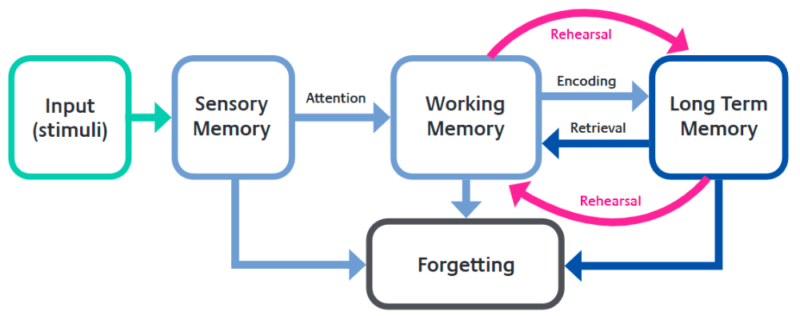Contents
What do we mean by memory and processing?
Memory can be separated into 3 stores:
- Sensory memory is a very short-term (less than a second) memory store for information being processing by the sense organs.
- Working memory is often thought of as a mental workspace, like a notepad that we can use to store important information in the course of our mental activities.
- Long-term memory consists of memories stored over an extended period of time. Long term memory can include skills (like bike riding) as well as memory for facts and events.
How psychology helps us to understand memory and processing:
The diagram below shows the multi-store model of memory.

AWAKE
A mnemonic to help us understand the model above:
- Attention. This is the first step in remembering something. We need to make sure that children focus on what is important and are not distracted.
- Working memory. The working memory has limited capacity and varies between children. The amount of information given needs to be managed to avoid overload.
- Active processing. Children need lots of practice at regular intervals, and to be asked questions to make them think deeply about a topic. This helps them develop longer lasting and stronger memories.
- Knowledge. In order for children to retain new information, they need to have good understanding and make links between new and old learning.
- Exercises. The brain can learn to retrieve information with practise. Children need lots of activities to practise retrieving and applying their knowledge.
Top tips to help children and young people
Moving things into the long-term memory (encoding)
- Make sure the information is understood. Information that is organised and makes sense is easier to lodge in the long-term memory.
- Think deeply (elaborative learning). Talk about the learning, ask questions, write and draw or act out the concepts.
- Do things ‘little and often’. Sometimes referred to as distributed practice. This involves doing little bits of rehearsal often, instead of a lot all at once.
- Link it. Make links with prior knowledge and future learning. Practise using knowledge in ways that are meaningful to the child.
For research on the above: Cognitive_science_approaches_in_the_classroom_-_A_review_of_the_evidence.pdf
Retrieving information from the long-term memory
- Revisit learning. Revisiting topics regularly throughout the term refreshes learning.
- Quiz and practise testing. For this to be most effective, it has to be done at low-stakes (which means it isn’t increasing stress) and spaced out. Short quizzes are better than a long test – keep it fun.
- Mix things up. Sometimes called interleaving, this is where either the types of problem or different subjects are mixed up. This helps keep things fresh.
- Use memorisation techniques (such as mnemonics!).
A guide to memory techniques can be found here; short-guide-memory-techniques.pdf (birmingham.ac.uk)
Managing working memory load
- Chunk information into manageable bits of learning.
- Scaffold learning by using diagrams, pictures and check lists to aid remembering.
- Use short and simple phrases when giving instructions and show how to do things.
- Teach children how to take and use notes.
A classroom guide to working memory can be found here; WM-classroom-guide.pdf (cam.ac.uk)
Five fab facts about memory:
- It has been proven by scientific research that the human brain starts to remember things from the womb. The memory starts to work just 20 weeks after conception.
- Short-term memory only lasts 20 to 30 seconds.
- The human brain’s storage capacity is virtually limitless.
- Caffeine only helps to increase alertness, it doesn’t maintain memory performances.
- Sleep is significant to memory. Sleep helps in the retrieval and storage of long-term memories.